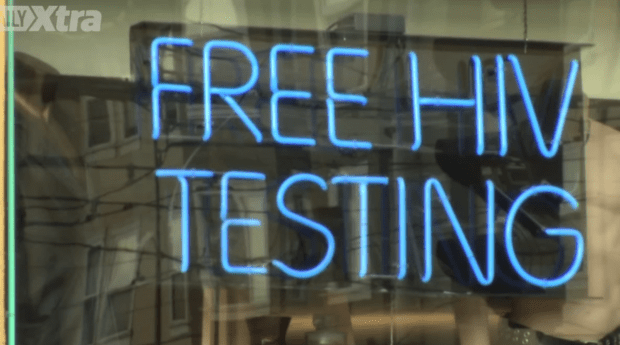2001 was a bad year for HIV.
After a steady decline over a decade, new HIV (human immunodeficiency virus) infections began to unexpectedly creep in an upward trend. In British Columbia, where infection rates had decreased every year since 1996, they jumped by eight percent.
In 1999, new infections among men who have sex with men had dropped to the same levels as heterosexuals; now they were diverging upward again.
Academics scrambled to understand what was going on. Words like “complacency” and “condom fatigue” crept into the lexicon. And, maybe worse than those, “barebacking.”
Researchers wondered why gay men would knowingly risk their health and lives to forgo condoms. Was it psychological damage, outright nihilism or a defiant backlash against public health authorities? Barebacking, one researcher wrote, was an alarming trend with “an almost cult-like following,” and with “the potential to shift safer sex norms as a whole.”
In the end, 2001 was only a brief setback.
Infection rates among straights soon continued downward. Among gay men, they stabilized, but did not fall.
The drumbeat of public health continued: wear a condom, wear a condom, wear a condom. The idea of barebacking, in the public forum, continued to be treated with discomfort. As gay porn producer Chi Chi Larue recently told Daily Xtra with flippant drag-queen disdain: “A test is a piece of paper, and it’s a false sense of security. Use a condom, people.”
Now, it’s important to note that most gay men do wear condoms. In fact, gay men wear condoms more diligently than any other group in Canada.
In the 2011 Canadian Sex Now survey, 70 percent of respondents said they had not had unprotected anal intercourse with a partner of unknown status in the past year.
But that leaves 30 percent who did, the so-called barebackers. Research by the BC Centre for Disease Control shows the number of gay men having sex without condoms rose significantly from 2001 to around 2006, where it settled at about a third. That number has not budged since. There is no barebacking crisis going on among gay men, but neither is it going away. A small but persistent group of gay men have made condomless sex a reality of the modern gay community — even if it is seldom discussed openly.
And a new generation of research shows that these men are not necessarily damaged or risk-seeking or rebellious. In fact, if you look closely, many of their decisions are entirely rational. It just depends how you ask.
Ryan is a 28-year-old professional living in Calgary. (Daily Xtra has changed his name, and the names of other barebackers in this story, to protect their anonymity.)
He is educated, engaging and articulate over the phone, and rattles off the results of scientific studies and the latest sexual-health buzzwords. He describes himself as private and risk-averse, and avoids local bars in the Prairies to avoid the hard-partying 20-year-olds. He’s HIV-negative, and plans to stay that way. He also barebacks, frequently.
Ryan is no irresponsible, drug-addled nihilist. He has simply put together two facts and made what he feels is a rational decision. The first fact is that HIV is not what it used to be: an inevitably infectious death sentence.
Today, HIV can be controlled with anti-retrovirals so effectively that several reputable studies show the risk of transmission from a positive person with an undetectable viral load is one in tens of thousands at most. And though it is only just making inroads in Canada, pre-exposure prophylaxis (PrEP) may soon make condomless sex even safer as well. Some HIV advocates are even pushing for sex between positive undetectable men and negative men on PrEP to be declared effectively completely safe.
Ryan takes full advantage by seeking out undetectable men for condomless sex. “They’re usually pleasantly surprised,” he says of partners who open up to him about being positive and undetectable. “Like, ‘Wicked, this guy does his research.’”
The second fact is one that gay men’s health advocates have been trying to ignore for decades: condomless sex, for these guys, just feels better.
“This is the biggest lie that people have been trying to tell,” says Olivier Ferlatte, a health researcher with the Community-Based Research Centre in Vancouver. “That sex with condoms is the same as sex without condoms. Anyone who has fucked without a condom knows that this is a crazy lie.”
Many men I spoke to described sex feeling better without a condom, sometimes in complex ways. One man couldn’t get hard with a condom on at all. Another liked the sensation of skin-to-skin intimacy. Ryan describes the attraction as a kind of psychological high that he can only reach when he knows there’s nothing between him and his lover.
Douglas, a retiree who has lived in Vancouver since the 1960s, weighs his decisions differently than Ryan, but with similar results.
In the midst of the HIV epidemic of the ’80s, when HIV was deadly and untreatable, Douglas withdrew from sex altogether. Now, he says, with only his retirement ahead of him and easily accessible anti-retrovirals, avoiding HIV seems less important. He jokes that, at this time of his life, he’s more concerned about heart disease than AIDS.
In 2000, while researchers were worrying about youth complacency, Douglas, in his 60s, was signing up for gay cruising site squirt.org and throwing himself back into the barebacking scene with abandon. (Squirt is owned and operated by Daily Xtra’s publisher Pink Triangle Press.)
“It just seemed to be opportune,” he says. “I was kind of making up for lost time. When they came up with what looked like a cure, it was time to be a little more uninhibited.”
Bill Coleman, a veteran counsellor who works with gay men, says the reasons men bareback are far broader than the physical. “Where people usually go in their heads is ‘I get more stimulation on my dick,’” he says, “but it can also feel better in that you’re closer to him, we feel more like one, it’s a symbol of trust, there isn’t this reminder of deadly disease.”
The focus on condoms, and denial about their shortcomings, has led researchers to misunderstand the kind of risk calculations that go on inside gay men’s heads.
“If you read a lot of health research, you’ll hear, ‘Oh, gay men are crazy for not using condoms,’” Ferlatte says. “In public health and the healthcare system there’s still a lot of stigma around unprotected sex. It’s easy to tell someone to use a condom, or that it’s still the same, or you should try harder, or drink less. But we all know that sex is very emotional. It’s a way to seek intimacy and pleasure.”
Researchers like Ferlatte are rewriting the way we look at gay men as decision makers. Gay guys are not simply choosing between the right option, condoms, and the wrong option, barebacking. Instead, they are making complex, multi-variable decisions, with complex outcomes. And sometimes, those outcomes don’t involve condoms.
Jody Jollimore, a program manager at the Health Initiative for Men (HIM) in Vancouver, says gay men don’t get enough credit for their health choices. “Serosorting and strategic positioning, where the negative guy [tops] and the positive guy [bottoms] are strategies that gay men invented,” he says. “We came up with those strategies for reducing HIV long before there was any science that said topping was less risky than bottoming. We figured it out.”
“Heterosexual men don’t like [condoms] either,” he notes. “But heterosexual men have found dozens of ways to prevent pregnancy. There’s the extreme example of abortion, there’s birth control, there’s IUDs, there’s spermicide. Gay men have one option, or at least until recently we had one option. We had condoms. It was a blunt tool. So when gays don’t like to use condoms, we’re ‘irresponsible.’ When everyone else doesn’t like to use them, it’s natural. I don’t understand why gay men are held to a different standard.”
Of course, not all gay men who are barebacking are as confident as Ryan is in his decision. Take Bison, a middle-aged man from Saskatchewan. He told me he hates condoms, and feels little sensation with one on. In a recent year-long fling with a married man, the two never really discussed condom use or HIV. They agreed not to use condoms, and that was that.
I can almost hear Bison shrug over the phone when I ask him if he felt he was safe. “I don’t know. It probably wasn’t,” he says. “I guess I felt somewhat safe because he stated that he didn’t play around. I just like sex, and I like sex without a condom.”
Bison has stayed negative, but realizes he walks a dangerous line. “I thought I was in monogamous, safe relationships before, but learned later that wasn’t the case,” he says. “I guess I’ve just been lucky.”
Stories like Bison’s underscore that there are still pitfalls to HIV prevention. If there weren’t, then HIV rates in gay men might be falling nearly as quickly as among heterosexuals. But the reasons for concern, as well as for hope, have to do with the startling complexity of the problem.
Ferlatte is at the forefront of a new line of research focusing on what is called a syndemic. A syndemic is a system of two mutually reinforcing diseases that feed off of each other: in this case, mental illness and HIV. It’s well established that mental illness among gay men, including depression, anxiety, body image problems and low self-esteem, are associated with higher risks of HIV. Ferlatte’s research adds that HIV stigma and anxiety also feed mental illness, creating a reinforcing loop.
This is a problem Coleman encounters frequently in his counselling practice. “What I’ve found is that a lot of people end up becoming positive after some crisis in their life,” he says. “The end of a relationship, losing their job, death of a loved one. Then they end up taking risks they usually wouldn’t.
“If someone’s really depressed, it’s hard to get the message out, ‘Be sure to take care of yourself so that you can live another 50 years of this horrible, miserable life.’”
The repeated enjoinder to “wear a condom,” Coleman and Ferlatte both feel, does not do enough to recognize the psychological and emotional factors that are driving HIV transmission. Condoms are good, they stress. But they are not good enough.
“If there were a simple answer to the HIV epidemic, we probably would have resolved it,” Ferlatte says. “There are people who pretend there’s one answer to this epidemic, and I would say they’re nuts. The literature keeps repeating that there are so many factors we need to take into account. Why would there be a single solution?”
What informed, risk-averse decision makers like Ryan and conflicted, struggling decision-makers like Bison have in common is the complexity of their decisions. Even if they weigh their options differently, both are weighing the payoffs of unprotected sex against the perceived risks, all in the context of HIV stigma, social pressure and the health information available to them.
What the new generation of researchers agree on is that complex decision makers need complex information to make good decisions. That means talking about condoms. But it also means talking about serosorting, undetectable viral loads, PrEP and everything in between.


 Why you can trust Xtra
Why you can trust Xtra


